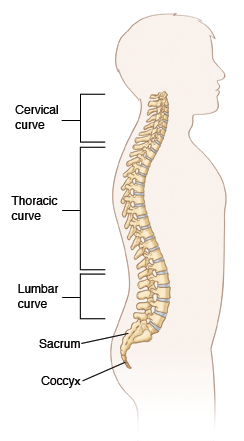General Neck and Back Pain

Both neck and back pain are usually caused by problems with the bones of the spine (backbones or vertebrae) and the muscles and ligaments that support it. Sometimes the disks that separate each bone of the spine may cause pain by pressing on a nearby nerve. Back and neck pain may appear after a sudden twisting or bending force (such as in a car accident), or sometimes after a simple awkward movement. In either case, muscle spasm is often present and adds to the pain.
Back and neck pain are common problems. Most people feel better in 1 or 2 weeks, and most of the rest in 1 to 2 months. Most people can stay active while they have the pain.
Pain related to disk disease, arthritis in the spinal joints, or narrowing of the spinal canal (spinal stenosis) can become chronic and last for months or years.
Low back pain is common in older adults. More than 50% of people over 60 experience it.
People have and describe pain differently.
-
Pain can be sharp, stabbing, shooting, aching, cramping, or burning.
-
Movement, standing, bending, lifting, sitting, or walking may make the pain worse.
-
Pain can be limited to 1 spot or area, or it can be more generalized.
-
Pain can spread upward, downward, to the front, or go down your arms or legs.
-
Muscle spasm may occur.
Most of the time, mechanical problems with the muscles or spine cause the pain. It's usually caused by an injury, whether known or not, to the muscles or ligaments. Pain is usually related to physical activity, such as sports, exercise, work, or normal activity. Sometimes it can occur without an identifiable cause. This can happen simply by stretching or moving wrong, without noting pain at the time. Pain without an injury is not common. But it can sometimes be caused by a health problem, such as kidney stones or an infection. Other causes include:
-
Overexertion, lifting, pushing, pulling incorrectly or too aggressively.
-
Sudden twisting, bending, or stretching from an accident (car or fall), or accidental movement.
-
Poor posture.
-
Poor conditioning, lack of regular exercise.
-
Spinal disc disease or arthritis.
-
Stress.
-
Pregnancy, or illness like appendicitis, bladder or kidney infection, pelvic infections.
Home care
-
For neck pain, use a comfortable pillow that supports the head and keeps the spine in a neutral position. The position of the head should not be tilted forward or backward.
-
When in bed, try to find a comfortable position. A firm mattress is best. Try lying flat on your back with pillows under your knees. You can also try lying on your side with your knees bent up toward your chest and a pillow between your knees.
-
At first, don't try to stretch out the sore spots. If there's a strain, it's not like the soreness you get after exercising without an injury. In this case, stretching may make it worse.
-
Don't sit for long periods, as in long car rides or other travel. This puts more stress on the low back than standing or walking.
-
During the first 24 to 72 hours after an injury, apply an ice pack to the painful area for 20 minutes and then remove it for 20 minutes. You can repeat it several times a day.
-
You can alternate ice and heat therapies. Talk with your doctor about the best treatment for your back or neck pain. Don't use a heating pad at bedtime. Sleeping with a heating pad can lead to skin burns or tissue damage.
-
Therapeutic massage can help relax the back and neck muscles without stretching them.
-
Be aware of safe lifting methods. Don't lift anything over 15 pounds until all the pain is gone.
Medicines
Talk to your doctor before using medicine, especially if you have other health problems or are taking other medicines.
-
You may use over-the-counter medicine to control pain, unless another pain medicine was prescribed. Talk with your doctor first if you have certain chronic conditions. These include diabetes, liver or kidney disease, stomach ulcers, gastrointestinal bleeding, or are taking blood thinner medicines.
-
Be careful if you're given pain medicines, narcotics, or medicine for muscle spasm. They can cause drowsiness. It can affect your coordination, reflexes, and judgment. Don't drive or operate heavy machinery.
Follow-up care
Follow up with your doctor as advised. You may need physical therapy or more tests.
If X-rays were taken, you'll be told of any new findings that may affect your care.
Call 911
Call 911 if:
-
You have trouble breathing.
-
You have confusion.
-
You feel very drowsy or have trouble waking up.
-
You faint or lose consciousness.
-
You have a very fast or very slow heart rate.
-
You lose bowel or bladder control.
When to contact your doctor
Contact your doctor right away if:
-
Your pain gets worse or spreads into your arms or legs.
-
You have weakness, numbness, or pain in 1 or both arms or legs.
-
You have changes in bowel or bladder function.
-
You feel numb in the groin area.
-
You have trouble walking.
-
You have a fever of 100.4ºF (38ºC) or higher, or as advised by your doctor.